UNEP Adaptation Gap Report 2025
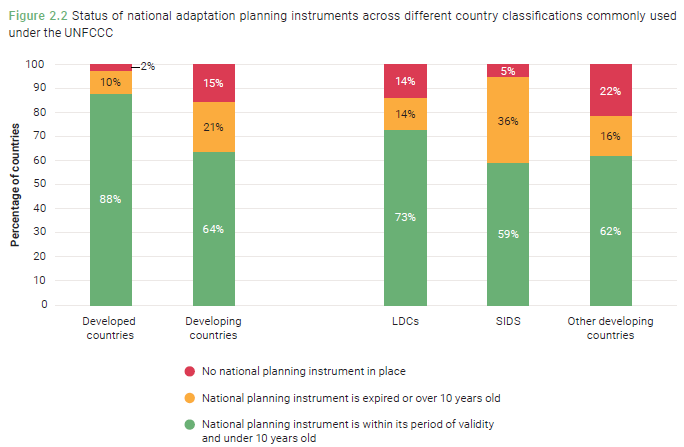
- 01 Nov 2025
In News:
The United Nations Environment Programme (UNEP) has released its flagship Adaptation Gap Report (AGR) 2025, titled “Running on Empty”.
The report warns that the global climate adaptation finance gap for developing countries has widened sharply, threatening progress toward climate resilience and the Sustainable Development Goals (SDGs).
About the Adaptation Gap Report (AGR)
- Publisher: UNEP–Copenhagen Climate Centre, with global institutional contributions.
- Purpose: Tracks progress in climate adaptation planning, implementation, and finance, assessing global preparedness against climate impacts.
- Relevance: Supports policy negotiations under the UNFCCC and upcoming COP30 (Belém, Brazil).
Key Findings
1. Escalating Finance Needs
- Developing nations will require USD 310–365 billion annually by 2035, potentially rising to USD 440–520 billion when adjusted for inflation.
- The growing need reflects increasing risks from both rapid- and slow-onset climate events—heatwaves, floods, sea-level rise, and glacial melt.
2. Widening Adaptation Finance Gap
- Current adaptation finance (2023): Only USD 26 billion, covering just one-twelfth of total requirements.
- Finance gap: USD 284–339 billion annually.
- Falling trends: Funding fell from USD 28 billion (2022), meaning the Glasgow Climate Pact target of doubling adaptation finance by 2025 will likely be missed.
3. Debt-Heavy and Unequal Finance
- About 58% of adaptation finance is in the form of loans, many non-concessional—deepening debt vulnerabilities among developing nations.
- This creates a growing risk of “adaptation debt traps”, undermining the principle of climate justice.
4. Progress and Planning Gaps
- 172 countries have at least one National Adaptation Plan (NAP); however, 36 of them are outdated.
- 1,600+ adaptation actions have been reported globally, primarily in agriculture, water, biodiversity, and infrastructure, but few measure tangible resilience outcomes.
- Small Island Developing States (SIDS) show the highest integration of adaptation into national policies.
5. Limited Private Sector Role
- The private sector contributes only USD 5 billion annually, despite potential investment capacity up to USD 50 billion with supportive de-risking mechanisms.
- Low engagement is attributed to high risk perceptions and limited blended-finance instruments.
6. Multilateral Fund Support
- Disbursements through the Green Climate Fund (GCF), Global Environment Facility (GEF), and Adaptation Fund reached USD 920 million in 2024—an 86% rise over the previous five-year average, though UNEP warns this may be temporary.
Global Frameworks and Roadmaps
Baku–Belém Roadmap (COP29–COP30)
- Envisions USD 1.3 trillion per year by 2035 in total climate finance.
- Stresses the need for grant-based and concessional instruments rather than debt-heavy finance.
- Aims to align finance, transparency, and adaptation under a “global collective effort” (mutirão global) led by Brazil’s COP30 presidency.
New Collective Quantified Goal (NCQG)
- Proposed USD 300 billion by 2035, but UNEP cautions that it is insufficient and not inflation-adjusted, hence failing to meet real adaptation needs.
India and the Adaptation Gap Report 2025
1. National and Regional Context
- India’s climate strategy now prioritises adaptation-centric policies over mitigation, focusing on resilient agriculture, water systems, and disaster management.
- Frequent heatwaves, floods, and glacial retreats heighten India’s vulnerability, underscoring the need for adaptive investments.
2. Policy and Institutional Response
- India’s National Action Plan on Climate Change (NAPCC) and State Action Plans align with UNEP’s adaptation priorities.
- Initiatives like the International Solar Alliance (ISA), Coalition for Disaster Resilient Infrastructure (CDRI), and LiFE Mission showcase India’s global leadership in climate diplomacy.
3. Financial and Structural Constraints
- India continues to face adaptation investment gaps, relying heavily on concessional and multilateral finance.
- Domestic efforts like the National Adaptation Fund for Climate Change (NAFCC) are under fiscal strain due to limited international flow.
4. Developmental Balancing
- India maintains that development precedes decarbonisation, in line with the principle of Common But Differentiated Responsibilities and Respective Capabilities (CBDR–RC).
- The Economic Survey 2024–25 reiterates that achieving developed-nation status by 2047 is essential before aggressive deep decarbonisation.
- India remains committed to Net Zero by 2070, consistent with its Long-Term Low Emissions Development Strategy (LT-LEDS).
Green Climate Fund
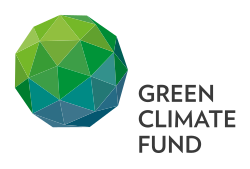
- 07 Jul 2025
In News:
- The Green Climate Fund (GCF) has approved over USD 120 million to support climate adaptation initiatives in Ghana, the Maldives, and Mauritania, with technical development by the UN Environment Programme (UNEP).
- The projects aim to build climate resilience among vulnerable populations through nature-based solutions, climate-resilient agriculture, early warning systems, and water security enhancements.
- These initiatives are critical in delivering adaptation finance to regions like Small Island Developing States (SIDS) and the Sahel, addressing some of the most urgent climate vulnerabilities and are expected to benefit over 3.5 million people.
Project Highlights by Country:
Ghana: Agroecological Resilience in Northern Regions
- Total funding: USD 70 million (USD 63 million GCF grant).
- Objective: Strengthen climate resilience in eight districts across North East, Upper East, and Upper West Ghana.
- Key Interventions:
- Improve access to climate data and early warnings.
- Enable dry-season farming via water storage.
- Restore 28,000 hectares of degraded land to improve water retention and soil health.
- Impact:
- Direct benefits for 619,000 people.
- Early warning systems to reach 2.9 million.
- Improved food security for 120,000 individuals.
- Implementing agencies: Ghana EPA and Ghana Meteorological Agency.
Maldives: Early Warning and Risk Reduction in a SIDS
- Total funding: USD 25 million.
- Project Name: Toward Risk-Aware and Climate-Resilient Communities (TRACT).
- Focus: Expand multi-hazard early warning systems and build national capacity under the Early Warnings for All (EW4All) initiative.
- Risks Addressed: Rising sea levels, storm surges, heatwaves, and coastal erosion threatening agriculture, fisheries, and tourism.
- Impact:
- Coverage for over 500,000 people.
- Special emphasis on remote and marginalized communities, including women and children.
Mauritania: Ecosystem Restoration in the Sahel
- Total funding: USD 33 million (USD 30 million GCF grant).
- Objective: Address desertification, drought, and water scarcity across four vulnerable regions.
- Key Activities:
- Build green-grey infrastructure to stabilize sand dunes.
- Improve water access for farming and land rehabilitation.
- Promote climate-resilient agriculture to reduce food imports.
- Impact:
- 85,000 people to benefit directly; 145,000 indirectly.
- 2,100 hectares of land to be protected.
- Supports the Great Green Wall Initiative—Africa’s flagship response to desertification.
Institutional Roles and Significance:
- The UNEP, as a global leader in environmental governance, has played a key role in contextualizing science-based, locally led climate solutions.
- The GCF, under the Paris Agreement framework, remains the largest international climate fund, supporting countries in implementing their Nationally Determined Contributions (NDCs).
UNEP’s NDC Cooling Guidelines 2025
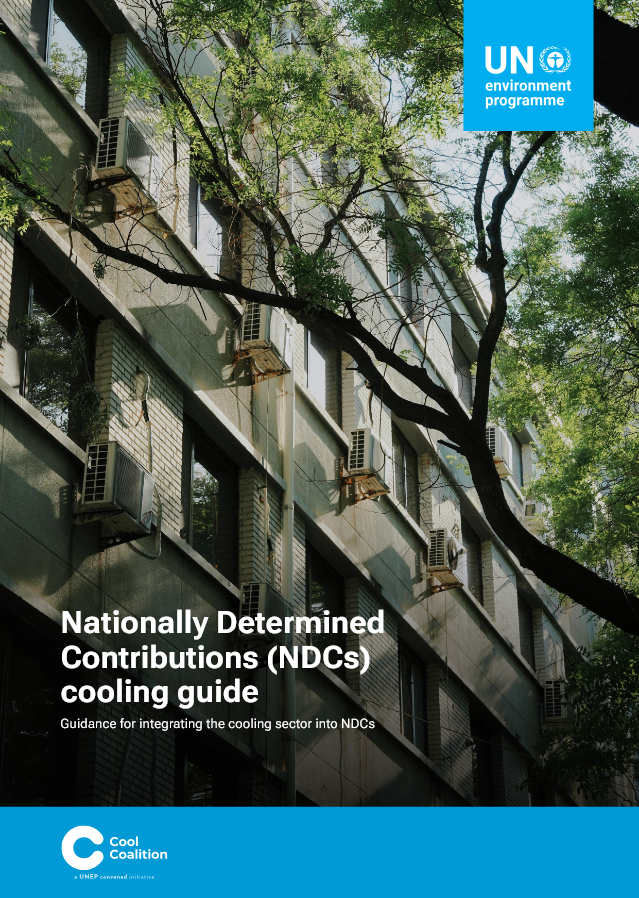
- 26 Jun 2025
In News:
The United Nations Environment Programme (UNEP) has released the NDC Cooling Guidelines 2025, aimed at supporting countries in integrating sustainable cooling strategies into their Nationally Determined Contributions (NDCs) under the Paris Agreement. The initiative addresses both climate mitigation and adaptation challenges posed by rising global temperatures and energy demand.
About the NDC Cooling Guidelines 2025
- Purpose:Provides a structured global framework for countries to incorporate sustainable cooling into national climate action plans, balancing mitigation, adaptation, and developmental needs.
- Developed by:UNEP’s Cool Coalition NDC Working Group, in collaboration with partners like UNDP.
- Primary Objectives:
- Mainstream sustainable cooling in national NDCs.
- Reduce sectoral emissions by 60% by 2050.
- Improve access to cooling for 1.1 billion vulnerable people.
- Establish robust Monitoring, Reporting, and Verification (MRV) mechanisms.
- Align with the Kigali Amendment to the Montreal Protocol and the Global Cooling Pledge.
Global Cooling Landscape: Key Data Points
- Current Impact:
- Cooling accounts for nearly 7% of global GHG emissions, projected to exceed 10% by 2050.
- Cooling consumes 20% of global building electricity, and up to 50% in countries like UAE.
- Access Challenges:1.1 billion people worldwide lack access to efficient and affordable cooling, threatening lives, food security, and healthcare.
- Efficiency Potential:By doubling appliance efficiency, access can expand sixfold without proportionate emission growth.
Challenges in the Cooling Sector
- Rising Emissions:Without immediate policy interventions, emissions from cooling are expected to double by mid-century, increasing climate and energy pressures.
- Access Inequality:Many low-income and rural populations remain exposed to extreme heat due to lack of sustainable cooling.
- Policy Gaps:Only 27% of updated NDCs currently include specific energy efficiency targets related to cooling.
- Gendered Impacts:Women, especially in vulnerable communities, face greater health risks from inadequate cooling and heat stress.
- Reinforcing Heat-Cooling Loop:Increasing temperatures escalate cooling demand, which if met with inefficient systems, leads to more emissions, exacerbating global warming—a vicious cycle.
Six-Step Framework in the Guidelines
- Baseline Assessment:Measure current energy use and refrigerant emissions in the cooling sector.
- Target Setting:Define clear, time-bound targets aligned with national climate priorities.
- Monitoring, Reporting, Verification (MRV):Develop transparent systems to track and report progress.
- Policy Tools:
- Introduce Minimum Energy Performance Standards (MEPS)
- Phase down high-GWP refrigerants
- Promote urban greening and passive cooling techniques
- Governance & Institutional Support:Establish cross-sectoral coordination, incorporating gender-sensitive planning.
- Financing & Equity:Mobilize investments and develop policies to enable equitable access to sustainable cooling technologies.
Country-Level Initiatives
- Nigeria:Integrated National Cooling Action Plan (NCAP) into its NDC, with a focus on heat-resilient rural infrastructure.
- United Arab Emirates (UAE):Adopted district cooling systems and high-efficiency air conditioning in its updated climate roadmap (NDC 3.0).
- Grenada:Committed to becoming the first HFC-free nation, aiming for complete refrigerant phase-down.
Protected Planet Report 2024
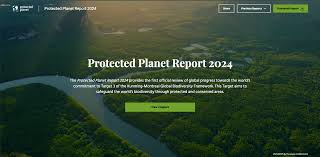
- 08 Nov 2024
In News:
The Protected Planet Report 2024, released by UNEP-WCMC and IUCN, evaluates global progress toward achieving Target 3 of the Kunming-Montreal Global Biodiversity Framework (KM-GBF). This target aims to conserve 30% of Earth's terrestrial, inland water, coastal, and marine areas by 2030.
Key Highlights of the Report
- Current Global Coverage
- Land and Inland Waters: 17.6% protected.
- Oceans and Coastal Areas: 8.4% protected.
- Progress since 2020: Minimal increase (<0.5% for both realms), equivalent to an area twice the size of Colombia.
- Remaining Challenges to Achieve Target 3 by 2030
- Land: An additional 12.4% of land area must be protected (equivalent to Brazil + Australia).
- Ocean: 21.6% more marine areas must be safeguarded (larger than the Indian Ocean).
- Key Gaps:
- Only 8.5% of protected areas on land are well-connected.
- Only one-fifth of the areas critical for biodiversity are fully protected.
- Biodiversity representation remains uneven, with some ecological regions having no protection at all.
- Governance and Effectiveness Issues
- Less than 5% of protected land and 1.3% of marine areas have management effectiveness assessments.
- Only 0.2% of protected land and 0.01% of marine areas have undergone equitable governance assessments.
- Indigenous governance covers less than 4% of protected areas despite Indigenous and traditional territories covering 13.6% of the terrestrial areas.
- Ocean Conservation Progress: Most progress is in national waters; however, areas beyond national jurisdiction (the high seas) remain underrepresented (<11% coverage).
- Data Deficiency: Insufficient data to measure biodiversity outcomes, equity, and governance in protected areas.
Importance of Target 3
- Biodiversity Benefits: Protected areas play a critical role in halting and reversing biodiversity loss.
- Ecosystem Services: These areas contribute to clean air, water, climate regulation, and food security.
- Cultural and Economic Significance: They uphold the rights of Indigenous Peoples and local communities, ensuring equitable governance and sustainable resource use.
Key Recommendations
- Accelerate Conservation Efforts:
- Expand protected and conserved areas with a focus on biodiversity hotspots.
- Ensure areas are ecologically connected and effectively managed.
- Strengthen Indigenous and Local Contributions:
- Recognize and support the stewardship of Indigenous Peoples and local communities.
- Ensure their voices and knowledge systems are integrated into conservation planning.
- Improve Governance and Equity:
- Address gaps in equitable governance and include rights-based approaches.
- Global Cooperation:
- Increase international financing to developing nations for biodiversity conservation.
- Foster cross-border partnerships and support data-sharing initiatives.
- Enhance Data Availability:
- Collect and disseminate data on the effectiveness of protected areas and their biodiversity outcomes.
India’s Role and Strategy
- Commitment to KM-GBF: India updated its National Biodiversity Strategy and Action Plan (NBSAP) to align with the KM-GBF goals, aiming to protect 30% of natural areas by 2030.
- Focus on Restoration: Prioritizes the restoration of forests, rivers, and other ecosystems to maintain essential resources like clean air and water.
- Indigenous Participation: India emphasizes integrating Indigenous territories into its conservation framework.
Adaptation Gap Report 2023 (DownToEarth)
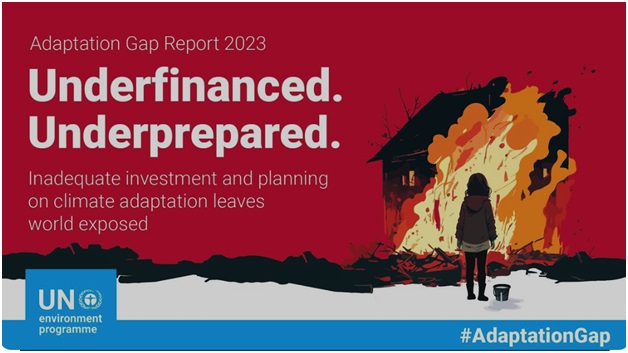
- 04 Nov 2023
Why in the News?
The Adaptation Gap Report states that funding for adaptation measures in developing nations has been declining and is insufficient of what is required.
About the Adaptation Gap Report:
- The Adaptation Gap Report (AGR) is an annual United Nation Enviroment Programme (UNEP) flagship publication.
- The report's primary objective is to inform the negotiators of the United Nations Framework Convention on Climate Change (UNFCCC) Member States, and the broader UNFCCC constituency, about the status and trends within climate adaptation at global and regional levels.
- AGR offers science-based recommendations to policymakers and decision-makers to enhance climate adaptation efforts in key climate-sensitive sectors.
- Since 2014, UNEP has been producing these assessments to support effective adaptation responses aligned with the UNFCCC's temperature and adaptation goals.
- The "adaptation gap" refers to the difference between actual adaptation efforts and the goals set by society, influenced by factors like climate change impacts, available resources, and competing priorities.
Key Findings of the Report:
- Adaptation costs are expected to rise significantly by 2050, especially in high-warming scenarios.
- The financial needs for adaptation are 10-18 times higher than the current international public adaptation fund flows.
- Urgent action is required to reduce greenhouse gas emissions and enhance adaptation efforts to protect vulnerable populations worldwide.
- In 2021, funding from developed countries to support adaptation projects in developing countries decreased by 15% compared to previous years.
- The report suggests seven strategies to bridge the adaptation gap, including increasing international financial support and mobilizing domestic resources.
- It also calls for a reform of the global financial system to facilitate easier access to climate-related funding from multilateral agencies such as the World Bank or the IMF.
